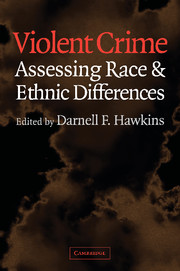Book contents
- Frontmatter
- Contents
- Contributors
- Foreword
- Editor's Introduction
- Violent Crime
- Part I Homicide Studies
- Part II Other Contexts, Settings, and Forms of Violence
- 6 Sanction Effects, Violence, and Native North American Street Youth
- 7 Ethnicity and Interpersonal Violence in a New Zealand Birth Cohort
- 8 Racist Victimization in England and Wales
- 9 Race, Gender, and Woman Battering
- 10 Gender Entrapment and African-American Women: An Analysis of Race, Ethnicity, Gender, and Intimate Violence
- Part III Explaining Racial and Ethnic Differences
- References
- Index
9 - Race, Gender, and Woman Battering
Published online by Cambridge University Press: 22 August 2009
- Frontmatter
- Contents
- Contributors
- Foreword
- Editor's Introduction
- Violent Crime
- Part I Homicide Studies
- Part II Other Contexts, Settings, and Forms of Violence
- 6 Sanction Effects, Violence, and Native North American Street Youth
- 7 Ethnicity and Interpersonal Violence in a New Zealand Birth Cohort
- 8 Racist Victimization in England and Wales
- 9 Race, Gender, and Woman Battering
- 10 Gender Entrapment and African-American Women: An Analysis of Race, Ethnicity, Gender, and Intimate Violence
- Part III Explaining Racial and Ethnic Differences
- References
- Index
Summary
Introduction
This chapter contributes to an exploration of the themes that drive this volume by analyzing the racial dimensions of woman battering. Part I introduces the problem, defines its scope, differentiates common domestic violence from the pattern of coercive control, and provides an overview of its significance. Drawing on population surveys primarily, Part II summarizes racial differences in the rates of domestic violence as well as in trends, demographics, dynamics, consequences, and in the response to interventions. Part III focuses on explanations for the unique configuration of battering in black couples, contrasting accounts that emphasize family pathology to cultural, historical, and political explanations. The conclusion considers possible sources of resilience and prevention in the black community.
The Scope of the Problem
Defining the Problem. In common parlance, domestic violence, family violence, spouse abuse, and woman battering are used interchangeably to refer to physical assaults in a family setting. Domestic violence statutes differ from state to state in which types of relationships and which types of violence they cover, although they universally focus on discrete acts of harm. In fact, in most relationships domestic violence is ongoing, not episodic, and is not literally “domestic,” because most victims are not married to and/or living with the persons who are hurting them. More important, the most devastating context of domestic violence involves a pattern of coercion and control where the physical assaults prohibited by law may be relatively minor.
- Type
- Chapter
- Information
- Violent CrimeAssessing Race and Ethnic Differences, pp. 171 - 197Publisher: Cambridge University PressPrint publication year: 2003
- 4
- Cited by

